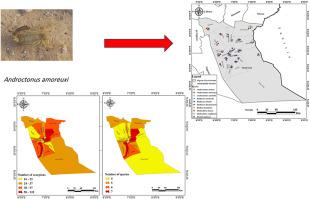Unveiling scorpionism in Northern Algerian Sahara (El Oued Province): Epidemiological trends and faunistic diversity
IF 2.4
4区 医学
Q2 PHARMACOLOGY & PHARMACY
引用次数: 0
Abstract
Scorpion envenoming is a major health problem in many countries, especially in rural regions such as El-Oued region (Algeria). Our study is a contribution to characterize the epidemiological situation of scorpion envenoming in the province of El Oued, by an exhaustive search for the causal species and an analysis of the epidemiological data of this region. During the study, we sampled a large number of scorpions belonging to ten scorpion species specialized in this biotope which qualified this region as a red zone, in particular Androctonus austalis (relative abundance = 48,72 %) the most dangerous species in Algeria.
Analysis of epidemiological data (2018–2024) showed that 34,640 cases of scorpion stings were reported, resulting in 10 deaths. When the morbidity shows an average annual incidence rate of 585.8 per 100,000 inhabitants. The highest incidence rate was reported in 2019, with 694.8 cases per 100,000 inhabitants, and the highest number of stings was recorded in 2020, (6259 cases). During the seven years of study, the scorpion stings affect more men than women, with a sex ratio of 2.86. This observation is noted for all age groups, the most affected being those aged 15 to 49, representing 64.39 % of cases. However, the scorpion stings are mostly concentrated (41.14 %) between 18h and 23h. While, September recorded the highest number of cases of the year with more than 1040. Mortality analysis shows an equal number of deaths between the sexes and the distribution of deaths by age group reveals a predominance among individuals aged 15–49 (40 %), noting that the highest case lethality rate in our study was recorded in 2018, at approximately 0.09 %, with 5 deaths.
Our study on the epidemiological and scorpion diversity in El Oued province represents a fundamental starting point for future research aimed at understanding the factors contributing to scorpion envenomation, particularly species diversity, proliferation factors, and the identification of red (high-risk) zones. These findings can help raise public awareness and guide citizens to avoid settlement or urban expansion in areas at risk.

揭示阿尔及利亚撒哈拉北部(El Oued省)的蝎子病:流行病学趋势和动物多样性。
蝎子中毒在许多国家是一个主要的健康问题,特别是在埃尔-乌伊德地区(阿尔及利亚)等农村地区。我们的研究是对El Oued省蝎子入侵的流行病学状况的贡献,通过对该地区的病因物种的详尽搜索和流行病学数据的分析。在研究过程中,我们采集了大量属于该生物群落特有的10种蝎子的样本,使该地区成为一个红色区域,特别是阿尔及利亚最危险的物种- - - austalus(相对丰度为48.72%)。流行病学数据分析(2018 - 2024年)显示,报告蝎子蜇伤病例34640例,死亡10例。当发病率显示平均年发病率为每10万居民585.8。据报道,2019年的发病率最高,每10万居民中有694.8例病例,而2020年的蜇伤数量最高,为6259例。在七年的研究中,蝎子蜇伤影响的男性多于女性,性别比例为2.86。这一观察结果适用于所有年龄组,受影响最大的是15至49岁的人群,占病例的64.39%。而蝎子蜇伤主要集中在18h ~ 23h,占41.14%。9月份的确诊病例超过1040例,创下了今年以来的最高记录。死亡率分析显示,两性之间的死亡人数相同,按年龄组划分的死亡人数分布显示,15-49岁的人占主导地位(40%),并指出我们的研究中最高的病例死亡率是在2018年,约为0.09%,有5人死亡。我们对El Oued省蝎子流行病学和多样性的研究为进一步了解蝎子中毒的影响因素,特别是物种多样性、增殖因素和红色(高风险)区域的确定提供了一个基础起点。这些发现有助于提高公众意识,并指导公民避免在危险地区定居或城市扩张。
本文章由计算机程序翻译,如有差异,请以英文原文为准。
求助全文
约1分钟内获得全文
求助全文
来源期刊

Toxicon
医学-毒理学
CiteScore
4.80
自引率
10.70%
发文量
358
审稿时长
68 days
期刊介绍:
Toxicon has an open access mirror Toxicon: X, sharing the same aims and scope, editorial team, submission system and rigorous peer review. An introductory offer Toxicon: X - full waiver of the Open Access fee.
Toxicon''s "aims and scope" are to publish:
-articles containing the results of original research on problems related to toxins derived from animals, plants and microorganisms
-papers on novel findings related to the chemical, pharmacological, toxicological, and immunological properties of natural toxins
-molecular biological studies of toxins and other genes from poisonous and venomous organisms that advance understanding of the role or function of toxins
-clinical observations on poisoning and envenoming where a new therapeutic principle has been proposed or a decidedly superior clinical result has been obtained.
-material on the use of toxins as tools in studying biological processes and material on subjects related to venom and antivenom problems.
-articles on the translational application of toxins, for example as drugs and insecticides
-epidemiological studies on envenoming or poisoning, so long as they highlight a previously unrecognised medical problem or provide insight into the prevention or medical treatment of envenoming or poisoning. Retrospective surveys of hospital records, especially those lacking species identification, will not be considered for publication. Properly designed prospective community-based surveys are strongly encouraged.
-articles describing well-known activities of venoms, such as antibacterial, anticancer, and analgesic activities of arachnid venoms, without any attempt to define the mechanism of action or purify the active component, will not be considered for publication in Toxicon.
-review articles on problems related to toxinology.
To encourage the exchange of ideas, sections of the journal may be devoted to Short Communications, Letters to the Editor and activities of the affiliated societies.
 求助内容:
求助内容: 应助结果提醒方式:
应助结果提醒方式:


